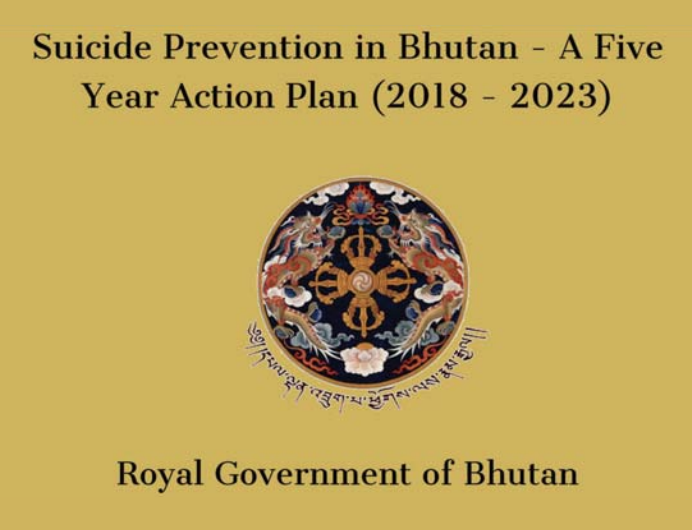FROM THE NATIONAL REPRESENTATIVE, BHUTAN, CHENCHO DORJI
Bhutan has launched its first suicide prevention program in 2015 (1) alongside its National Mental Health Program which was in existence since 1997 with an emphasis on building the capacity of primary health care workers in managing mental health and suicide prevention and improve accuracy of reporting.
The project was reviewed in 2018 and upscaled to a five-year project with emphasis on a combination of top-down and bottoms-up multi-disciplinary strategy (2). School counselors, local government leaders and volunteers will now work hand in hand with health workers in the community to address the growing suicide problem (12 suicides per 100,000 population) in the country.
In the wake of the COVID-19 outbreak in the country in March 2020, Bhutan has intensified its mental health and suicide prevention program by launching a dedicated National COVID-19 Mental Health and Psychosocial Response Team (MHRT) and established telephone and online social media helplines at both the national and community for counselling, screening, and referral of high-risk suicide cases (3). These online facilities have increased the accessibility to mental health services, which otherwise are not accessible to far-flung rural areas. The anonymity provided by digital technology facilitated more people and especially the youth to seek help. These online facilities also promoted distance learning and training of health workers and gatekeepers of suicide at less expenses to the government.
The MHRT has so far trained more than 20,000 health workers, counselors and volunteers on psychological first aid and suicide prevention (3). Webinars targeting frontline health workers, counselors, volunteers and youth are held every week. Mass and social media are used to inform and educate the general public. Standard operating procedures and guidelines are used to train suicide gatekeepers and news reporters. Reducing means of suicide through control of lethal means such as pesticides (4) and firearms are part of the suicide prevention program. High-risk suicide groups such as people with mental disorders, substance use, vulnerable sections of society such as youth, unemployed and elderly are targeted, screened and offered free treatment.
Youth poses the highest risk of suicide in Bhutan like in other countries. Efforts are being made to include life skills, problem-solving and mindfulness practices in the school teaching curricula and training of teachers. Education of primary care physicians and health workers on mental health and suicide prevention remain as the bed rock of suicide prevention program. Enhancing their knowledge and skills on identification of high-risk individuals and training them on brief suicide prevention intervention has shown demonstrable results in reducing suicide.
Although Bhutan has done very well in containing the spread of the COVID-19 in the community and preventing deaths so far by aggressive tracing, testing and treatment of affected people, it is inevitable that the adverse psychological, social and economic impact of the pandemic will affect the mental health of the population and increase risk of suicide. Mitigation measures by the Royal Government of Bhutan such as deferment of bank loans and social security benefits to affected people have shown demonstrable results. However, given that Bhutan has a long porous border and economically dependent on neighboring countries with high prevalence of the virus, the risk of the virus spreading in the country remains high (5).
Availability of a functional community-based mental health services is the backbone of an effective suicide prevention strategy. The UN Sustainable Development Goals (SDG) target reduction of suicide as one of the key indicators (6). The COVID-19 situation has put a setback on achieving the SDG targets. In the face of mounting challenges, innovative measures to strengthen the mental health services and suicide prevention are deemed necessary. Making use of digital technology, reaching out to community leaders, online training of service providers and counseling of high-risk suicide cases and referral to treatment centres are the cornerstones of contemporary Bhutanese suicide prevention program.
References:
- Dorji G, Choki S, Jamphel K, Wangdi Y, Chogyel T, Dorji C, Nirola DK. Policy and
governance to address depression and suicide in Bhutan: The national suicideprevention strategy. WHO South-East Asia J Public Health 2017 6:39-44. - Suicide Prevention in Bhutan – A Five Year Action Plan 2018 – 2023 Ministry of
Health, Royal Government of Bhutan 2019 - Ministry of Health, Royal Government of Bhutan – National Covid-19 Mental
Health and Psychosocial Response Team Report- personal communication –
Dr. Chencho Dorji, July 2020 - Royal Government of Bhutan, Pesticides Rules and Regulations of Bhutan, RGOB, 2019
- Mark Turner, UNSW Canberra- Bhutan’s decisive response to COVID-19, East
Asia Forum, Economics, Politics and Public Policy in East Asia and the Pacific, 6
November, 2020 - World Health Organization, Sustainable Development Goals Target 3.4 –
Noncommunicable diseases and mental health – Suicide Target 3.4.2




